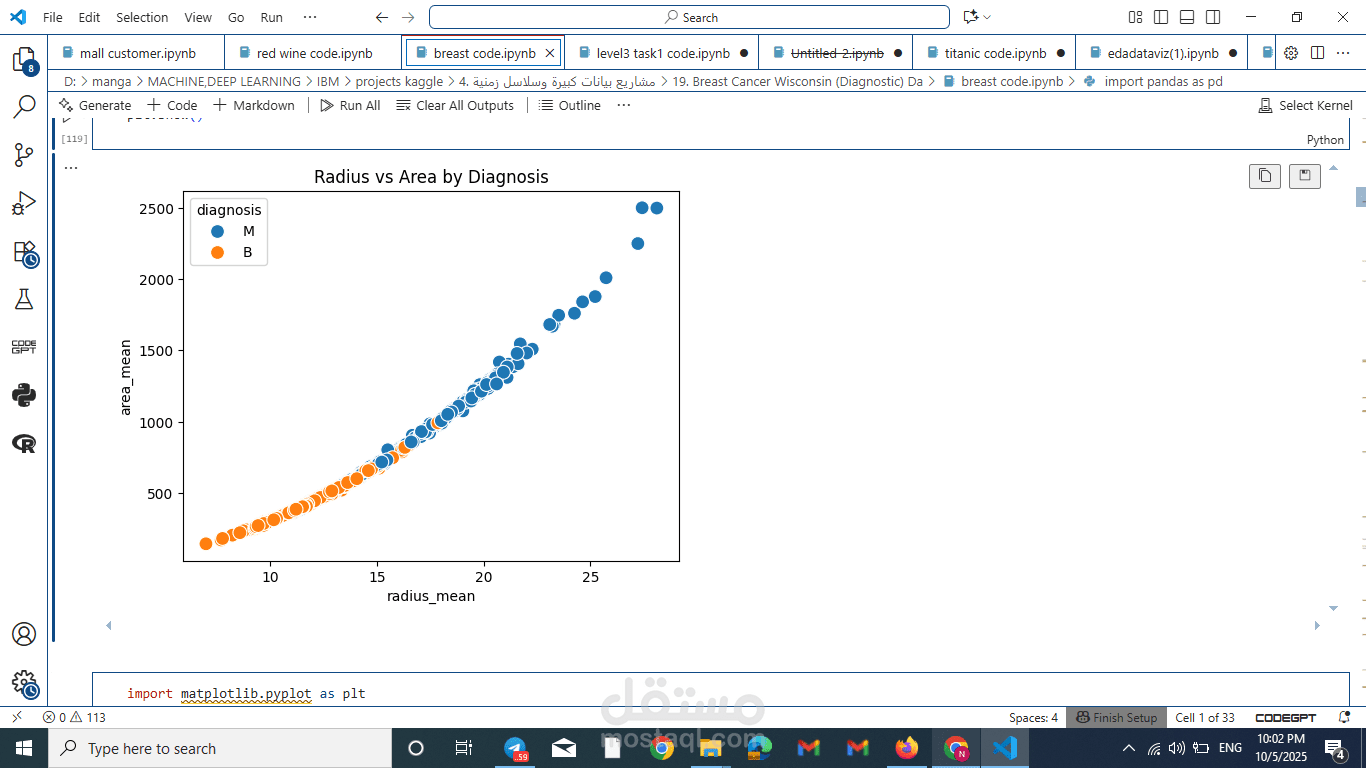Breast Cancer Classification Project
تفاصيل العمل
Breast Cancer Classification Project Report ?
1. Project Overview
This project aimed to predict breast cancer diagnoses (benign vs malignant) using the Breast Cancer Wisconsin (Diagnostic) dataset. The workflow involved data exploration, preprocessing, feature analysis, model training, and evaluation, focusing on building accurate and reliable machine learning models to support clinical decision-making.
________________________________________
2. Data Exploration & Preprocessing
The dataset consists of 569 samples and 32 features, including ID and the target column diagnosis. The distribution of the target is roughly 63% benign and 37% malignant.
Data quality checks confirmed no missing values.
Preprocessing Steps:
•Scaling: Applied RobustScaler to handle outliers effectively.
•Encoding: Converted diagnosis labels to numerical values (0 = Benign, 1 = Malignant).
Visual Insights (described):
•Boxplots: Malignant tumors generally have larger radius, perimeter, and area than benign tumors.
•Scatterplots: radius_mean vs area_mean shows clear separation between benign and malignant cases.
•Correlation Heatmap: Features like concavity_mean and perimeter_mean show the strongest correlation with the diagnosis, highlighting their predictive power.
________________________________________
3. Feature Analysis
•Top Predictive Features: radius_mean, area_mean, perimeter_mean, concavity_mean.
•These features are critical indicators of cell size and shape irregularities, which are commonly associated with malignancy.
•Feature visualization helps understand which attributes contribute most to diagnosis, guiding both model development and clinical interpretation.
________________________________________
4. Model Development & Evaluation ?
Models Trained:
•Logistic Regression – baseline linear model
•Random Forest – ensemble of decision trees
•SVM – linear kernel
•XGBoost & LightGBM – gradient boosting models
•Voting Ensemble – combined the best-performing models
Performance Highlights:
•Gradient Boosting models (XGBoost & LightGBM) achieved ~99% accuracy.
•Logistic Regression performed well (~97–98%).
•Ensemble method improved stability and robustness, leveraging strengths of individual models.
Visual Concepts (described):
•Feature Importance: Bar plots showing top features, with longer bars indicating stronger predictive power.
•Confusion Matrices: Most models correctly classified nearly all benign and malignant cases. Misclassifications were minimal.
•Model Comparison: F1-macro scores illustrated using bar charts, highlighting the superior performance of ensemble and gradient boosting models.
________________________________________
5. Insights & Key Takeaways
•Malignant tumors tend to have larger and more irregular nuclei, reflected in features such as radius_mean, perimeter_mean, and concavity_mean.
•Gradient Boosting models capture complex non-linear patterns, outperforming linear models.
•Ensemble methods enhance prediction stability and robustness.
•Cross-validation confirmed consistent high F1-macro scores, ensuring reliable model performance.
6. Conclusion
This project successfully developed a robust machine learning pipeline for breast cancer diagnosis. Key findings include:
•High accuracy models that can support early detection and clinical decision-making.
•Identification of key predictive features, enabling better understanding of tumor characteristics.
•Ensemble models providing accuracy, stability, and generalization, making them suitable for clinical applications.
________________________________________
7. Next Steps
1.Integrate explainable AI (XAI) techniques for model interpretability.
2.Develop a user-friendly clinical application for doctors to input patient features and receive predictions.
3.Expand the dataset to include multi-center or longitudinal data for improved generalization.
4.Visualize feature importance and model comparisons with professional infographics for presentations.
